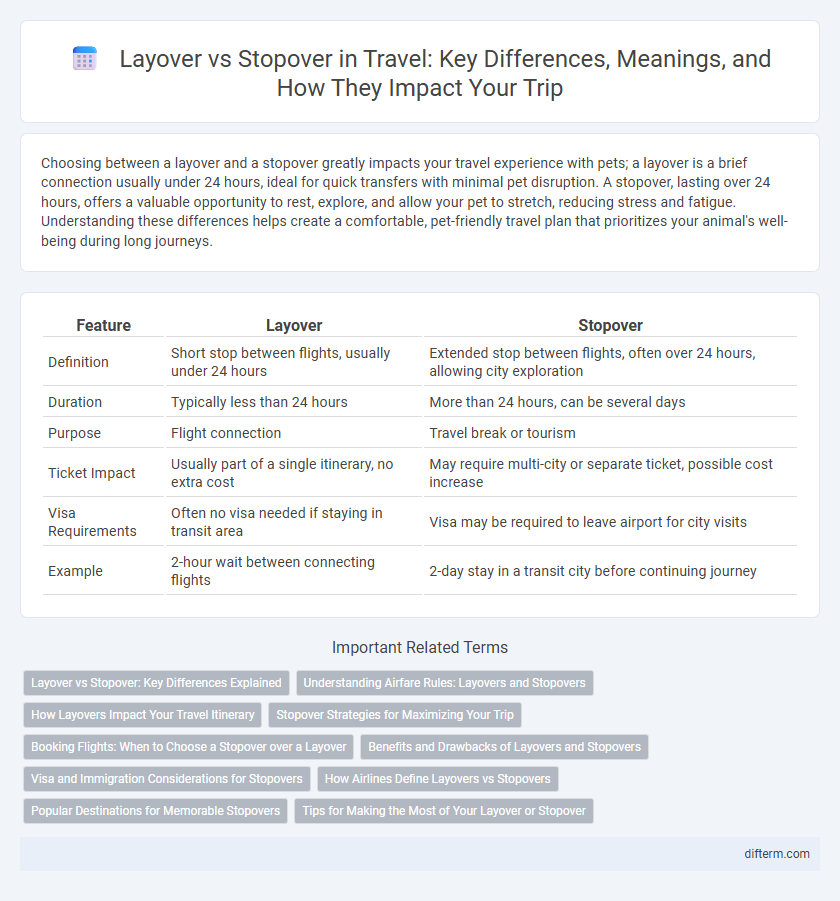Choosing between a layover and a stopover greatly impacts your travel experience with pets; a layover is a brief connection usually under 24 hours, ideal for quick transfers with minimal pet disruption. A stopover, lasting over 24 hours, offers a valuable opportunity to rest, explore, and allow your pet to stretch, reducing stress and fatigue. Understanding these differences helps create a comfortable, pet-friendly travel plan that prioritizes your animal's well-being during long journeys.
Table of Comparison
| Feature | Layover | Stopover |
|---|---|---|
| Definition | Short stop between flights, usually under 24 hours | Extended stop between flights, often over 24 hours, allowing city exploration |
| Duration | Typically less than 24 hours | More than 24 hours, can be several days |
| Purpose | Flight connection | Travel break or tourism |
| Ticket Impact | Usually part of a single itinerary, no extra cost | May require multi-city or separate ticket, possible cost increase |
| Visa Requirements | Often no visa needed if staying in transit area | Visa may be required to leave airport for city visits |
| Example | 2-hour wait between connecting flights | 2-day stay in a transit city before continuing journey |
Layover vs Stopover: Key Differences Explained
Layover and stopover both refer to scheduled breaks during a flight but differ primarily in duration and purpose. A layover typically lasts less than 24 hours for domestic flights and under 4 hours internationally, mainly serving as a brief connection between flights without leaving the airport. In contrast, a stopover exceeds 24 hours on international itineraries, allowing travelers time to exit the airport and explore the layover city before continuing to their destination.
Understanding Airfare Rules: Layovers and Stopovers
Layovers and stopovers are distinct terms in airfare rules, affecting ticket pricing and itinerary planning. A layover is a short pause between connecting flights, usually under 24 hours, while a stopover extends beyond 24 hours, often allowing travelers to explore a city before continuing. Airlines may charge differently for stopovers, impacting overall trip cost and flexibility in travel arrangements.
How Layovers Impact Your Travel Itinerary
Layovers impact your travel itinerary by affecting total travel time and passenger comfort during connections. Short layovers can increase the risk of missed flights, while longer layovers provide opportunities to explore the connecting city but may extend overall journey duration. Airlines often design layover times to balance efficient transfers with minimal disruption to passenger schedules.
Stopover Strategies for Maximizing Your Trip
Stopover strategies maximize your trip by allowing extended stays in connecting cities, turning transit time into opportunities for exploration and cultural immersion. Airlines often offer free or low-cost stopovers, enabling travelers to visit multiple destinations without additional airfare. Planning stopovers strategically can enhance travel experiences, reduce jet lag, and expand itineraries without increasing overall travel costs.
Booking Flights: When to Choose a Stopover over a Layover
Booking flights with a stopover offers travelers the opportunity to explore an additional city for several hours or even days, often without extra airfare costs, enhancing the overall travel experience. Layovers, typically short and under 24 hours, are primarily designed for quick plane changes and do not allow time for extended local exploration. Choosing a stopover is ideal for tourists seeking to maximize destinations in a single trip, while layovers prioritize efficient routing and minimal travel time.
Benefits and Drawbacks of Layovers and Stopovers
Layovers provide quick transitions between flights, minimizing overall travel time but often limiting the opportunity to explore the connecting city. Stopovers allow travelers to stay in a destination for an extended period, offering the chance to experience local culture, but they may increase total trip duration and cost. Evaluating the benefits and drawbacks depends on travel priorities such as convenience versus exploration.
Visa and Immigration Considerations for Stopovers
Stopovers often require travelers to undergo visa and immigration procedures since they involve staying in a transit city for more than 24 hours, which can necessitate a short-term visa depending on the destination country's regulations. Airlines and immigration authorities treat stopovers as temporary entry, meaning travelers must comply with local entry requirements, including passport control and customs inspections. Understanding the specific visa policies of the stopover country is essential to avoid travel disruptions and ensure smooth transit through international airports.
How Airlines Define Layovers vs Stopovers
Airlines define layovers as short waiting periods between connecting flights, usually under 24 hours for domestic and 24 hours to 4 hours for international travel, where passengers remain in transit without leaving the airport. Stopovers are extended breaks exceeding these durations, often lasting over 24 hours, allowing travelers to leave the airport and explore the layover city. These definitions impact ticket pricing, routing options, and baggage handling policies, influencing travel planning and airline fare structures.
Popular Destinations for Memorable Stopovers
Popular destinations for memorable stopovers include cities like Dubai, Singapore, and Reykjavik, known for their world-class amenities and unique cultural experiences. Layovers typically last a few hours, whereas stopovers extend over 24 hours, allowing travelers to explore attractions such as Burj Khalifa, Marina Bay Sands, or the Blue Lagoon. Airlines often offer stopover packages that include hotel stays, guided tours, and local dining options to enhance the travel experience.
Tips for Making the Most of Your Layover or Stopover
Maximize your layover or stopover by researching airport amenities such as lounges, dining options, and nearby attractions to optimize downtime. Pack essentials like chargers, toiletries, and a change of clothes to stay comfortable and prepared for any delays. Utilize apps to track flights and book short city tours or airport hotel rooms, transforming wait times into enjoyable experiences.
layover vs stopover Infographic

 difterm.com
difterm.com